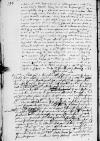1537-03-16⌊Hodie1537-03-16⌋ ⌊hinc⌋ absolvi nuntium meum cum ⌊⌋, meo et Dominationis Vestrae Reverendissimae sigillo, quod iis inclusum re superinscribed⌈rere superinscribed⌉mitto, obsignatis. Quarum hic addidi exemplum. Et cum iam, antequam sigillum Dominationis Vestrae Reverendissimae accepissem, ⌊⌋ manu mea superinscribed⌈manu meamanu mea superinscribed⌉ absolvissem, addidi, pertaesus rescribendi laborem, ultimum in calce articulum, cum quo procul dubio pro sua in me benevolentia Dominatio Vestra Reverendissima erit contenta etc.
Quicquid a ⌊maiestate regia⌋ et a superinscribed⌈et aet a superinscribed⌉ ⌊reverendissimo domino Plocensi, Regni cancellario⌋, respondebitur, Dominatio Vestra Reverendissima sciet cum primis. 1537-03-15⌊Heri1537-03-15⌋ etiam accepi a venerabilibus dominis ⌊Tidemanno Gise⌋ custode et ⌊Felice Reich⌋ canonico Varmiensi ⌊Frauenburgi⌋ 1537-02-25⌊XXV mensis Februarii superinscribed⌈FebruariiFebruarii superinscribed⌉ praeteriti1537-02-25⌋ datas ⌊⌋, quibus a me statui sibi superinscribed⌈sibisibi superinscribed⌉ tempus postulant, quando in negotio conficiendae coadiutoriae ad me cum articulis on the margin⌈cum articuliscum articulis on the margin⌉[1] divertere deberent superinscribed in place of crossed-out possent⌈possentdeberentdeberent superinscribed in place of crossed-out possent⌉. Sique res morulam aliquam ferret posset superinscribed⌈possetposset superinscribed⌉, rogabant profectionem eorum ad me differri, quousque via fieret siccior et planior. Proinde diem illis pro 1537-04-08⌊Dominica Quasi modo geniti1537-04-08⌋ assignavi. Interea quaeso me edocere velit Dominatio Vestra Reverendissima superinscribed⌈Dominatio Vestra ReverendissimaDominatio Vestra Reverendissima superinscribed⌉, quemadmodum et prius rogavi, quomodo me in omnibus cum illis gerere debeam, etsi {si}quid super iis articulis cum Dominatione Vestra Reverendissima contulerunt vel quidpiam immutarunt. Quod reliquum est, me paterno amori Dominationis Vestrae Reverendissimae summopere commendo, cui a domino Deo aetatem longo tempore incolumem et omnia fausta precor.


 BCz, 244, p. 198
BCz, 244, p. 198